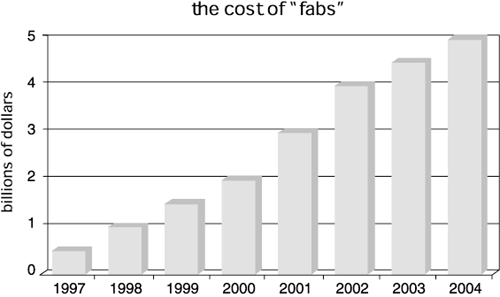Fab Plant Sticker Shock
In 1966, the cost for building a semiconductor fabrication plant—also called the 'tab for a fab' topped $14 million dollars. By 1995, an up-to-date plant could cost almost $1 billion. Each generation of plants requires more exotic and precise equipment to develop and turn out large numbers of the next generation of microprocessors.
Under Moore's Second Law, the general rule is that the cost of creating new, up to date manufacturing facilities doubles every generation. In the late 1980s, billion-dollar plants seemed almost inconceivable. However, at this point in time Intel alone has two plants under construction that will cost more than $2.5 billion apiece.
Fabrication development people try to reutilize as much of the previous generation's equipment as possible. However, even with the increasing number of joint ventures—much like our own with Intel—the building of a new plant remains one of the largest outlays of capital of any business field. Under Moore's second law, by 2005 the cost for a fab plant could be up as high as $10 billion.
As can be seen in Figure 6-1, the price of constructing a plant to build the processors (also known as a 'fab' plant) has soared far beyond the cost curve of any industry when it is building a new piece of equipment.
Figure 6-1. The Astronomical Rise in the Cost to Construct a Fab Plant

Therefore, the decision to build a plant that upholds Moore's first law of increasing processor power is one that is linked at the hip to the Second Law. If the return on investment is not there to justify spending on the scale that the Second Law demands, the first one will not be upheld. Place yourself in the position of a manufacturer like Intel—if you're going to spend $4 billion on a factory and you make 100 million chips, you know how to price accordingly to get the return by selling on the mass market. But what if you can only make 10 million chips? This may not be Intel's dilemma, but it is the problem facing every other manufacturer of their own proprietary chips.
Therefore, results of Moore's First Law are only directly dependent on the number of transistors on a microchip. When looked at with a slightly wider lens, it's apparent that what the results are linked to are the ability to make more sophisticated manufacturing plants economically feasible in the 18-24 month time span. The true dependency hangs on whether or not a manufacturer like IBM, Hewlett-Packard, or Intel had the financial and technical know-how and stamina to be able to continue building new and improved plants to churn out these faster chips.
